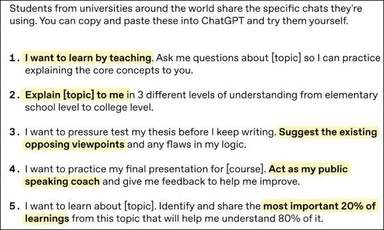Students excel when they feel supported, invested, and challenged. AI offers a new way to support students via self-directed learning that pushes them just beyond their current abilities.

Many students are already integrating AI into the learning process. Recent data from OpenAI reveals that students are using ChatGPT to prepare for assessments in a variety of ways, with chats ranging from simple topic explanations to motivational prompts. While students clearly seek this kind of individualized learning, faculty guidance can help shift the experience from trial-and-error experimentation to purposeful practice.
There are two key issues to consider. First, some students may be hesitant to use AI without guidance. Second, even small variations in student prompts can create a wide range of responses, making it difficult to ensure accuracy. With your oversight and norm-setting, you can address these issues and enable all your students to take advantage of this formative learning tool.
Ready to give it a try?
Share pre-made prompts that include [replaceable bracketed text] with your students. This provides a consistent tutor experience while still tailoring the activity to individual learning needs. Here are some prompts students can copy and paste into university-supported Microsoft Copilot:
Personalized Quiz
This prompt generates a practice quiz that adjusts based on student responses.
Create a ten-question multiple-choice quiz appropriate for a second-year college undergraduate that tests me on [the role of mitochondria]. Give me questions one at a time and do not provide feedback until the end. Create a study guide based on my results.
Scaffolding Complex Topics
Use this prompt to break down a complicated concept step by step and link it to prior knowledge.
I’m struggling to understand [microbiomes] in my college class. Please break down this topic by: starting with the simplest explanation, using everyday analogies; adding a layer of detail that connects to what I’ve already learned in class; providing a worked example or real-world application; asking me a practice question to check my understanding before moving to the next level; and summarizing the key takeaways at the end.
Debate Partner
This prompt encourages critical thinking by asking the AI to challenge assumptions and push back on arguments.
I’m studying [utilitarianism] as an undergraduate. I want you to act as a debate partner who pushes back on my arguments. Challenge assumptions, point out weaknesses, and demand evidence. Keep your responses concise but sharp, like someone trying to win a classroom debate. After each round, rate the strength of my argument (1–10) and tell me one way I could make it stronger before we continue.
As you incorporate AI into your teaching strategies, encourage reflection and analysis. For example:
Provide reflective questions for students at the conclusion of AI-enabled assignments to encourage metacognition.
Encourage students to bring AI transcripts to meetings with you for analysis.
Integrate the AI transcript into an assessment. Have students submit the transcript with a short reflection that explains how the AI helped them with a specific problem, and where the tool’s limitations became clear.
When you include AI thoughtfully in your course design, you shift the tool from a source of academic integrity concern to an engine for student learning. Your structured approach and guidance can turn trial-and-error experimentation into intentional practice and help students develop transferable strategies for learning and working with AI.